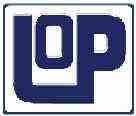|
Exploring the Lake Geneva Region
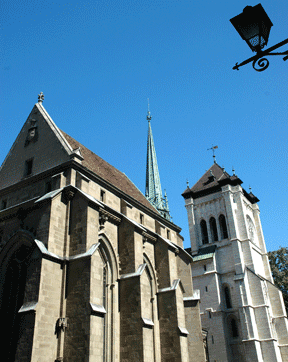 Geneva is a very convenient gateway into Switzerland and the Alps. Zurich's bustling airport is perhaps the most known international arrival destination, but we found the Geneva airport
(and city) to be much easier to negotiate. Flight schedules from
US gateways can be consulted for availability. The train station is only steps away from the arrival gates, perfect for travelers who
continue on to other cities in the Matterhorn Region. Geneva, with a population of less than one half million, is home to many international organizations such as the European United Nations,
World Health Organization and the Red Cross. About 1/3 of its population are residents from 157 nations represented by these organizations.
Geneva is a very convenient gateway into Switzerland and the Alps. Zurich's bustling airport is perhaps the most known international arrival destination, but we found the Geneva airport
(and city) to be much easier to negotiate. Flight schedules from
US gateways can be consulted for availability. The train station is only steps away from the arrival gates, perfect for travelers who
continue on to other cities in the Matterhorn Region. Geneva, with a population of less than one half million, is home to many international organizations such as the European United Nations,
World Health Organization and the Red Cross. About 1/3 of its population are residents from 157 nations represented by these organizations. Despite its international reputation, Geneva may not be the
tourism destination that many believe. It is an unassuming city, quietly revealing some interesting sights and historical corners. The most unique walking tour is Carouge, just across the river
from Geneva. In 1754, architects from Turin, Italy, were instructed to design a city that could compete economically with its larger neighbors. The city was designed around Place du Marche, a
central plaza and a favorite for pedestrian. Take any city bus that crosses the river and walk to the corner of Rue St Joseph and Rue de la Filature to
discover numerous small crafts shops, where each owner makes, displays and sells his/her products.
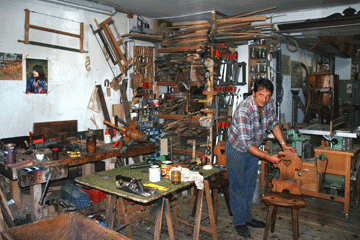 Hours of operation vary, depending on each owner, but all are
closed during the noon lunch hour (in fact, this is the case throughout Switzerland no matter the size of the store). St. Pierre's Cathedral, with its eclectic architecture, is also a focal
point of the "Vielle Ville." Hours of operation vary, depending on each owner, but all are
closed during the noon lunch hour (in fact, this is the case throughout Switzerland no matter the size of the store). St. Pierre's Cathedral, with its eclectic architecture, is also a focal
point of the "Vielle Ville." Geneva is also home to the largest freshwater lake in Western Europe. Typically known as Lake Geneva, its real name is Lac Leman, reverting to its Roman roots. Naturally, the area is
perfect for the beautiful parks and pedestrian walks. A water fountain that shoots water skyward 460 feet lies in the harbor.
A popular activity, which we also enjoyed, is dining aboard one of the boats that traverse the lake, with the Savoy Alps and the Dents-du-Midi mountains on the French side as a background. Relax and enjoy
this excellent dining experience!
Other recommended dining options in Geneva are restaurant Les Armures, Geneva's oldest, located adjacent to the armory, or Le
Lyrique, adjacent to the Opera house. Both offer an informal atmosphere and delicious choices for lunch or dinner. For hotel options, click here. For more details on Geneva, visit
http://www.geneva-tourism.ch/eng/index.php3.Museums and Castles The Olympic Museum is a worthwhile visit if you are spending more than one day in the area. Journey
back into the age-old history of the games in the 5-level, artistically-designed museum. You'll discover interesting audiovisual presentations, picture exhibitions and collections of past Olympics. Among the
more than 87,000 exhibits are all of the Olympic torches of games past, a very interesting exhibit! Pick up a Visitor's Guide which is a great reference for past and future winter and summer games..
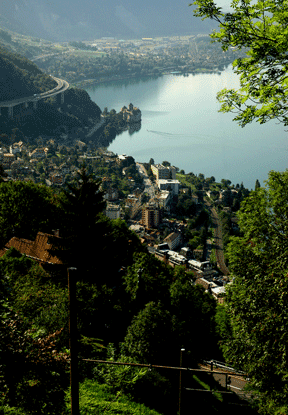 Of definite interest and not to be missed in the Montreux-Vevey area is a visit to Chillon Castle. It is an impressive medieval structure which is kept
in very good condition, and the source of Lord Byron's "The Prisoner of Chillon." You can't help but imagine life in the 13th century as you walk through the grand halls and sleeping chambers.
The kitchen features the original wooden ceiling, and throughout the castle, the gothic designed windows that open to views of the lake. The original wall paintings are still evident in the Lord's
Chamber. Even the latrine is interesting, with a downward view to the lake small enough for the necessary, but too small for escape. Of definite interest and not to be missed in the Montreux-Vevey area is a visit to Chillon Castle. It is an impressive medieval structure which is kept
in very good condition, and the source of Lord Byron's "The Prisoner of Chillon." You can't help but imagine life in the 13th century as you walk through the grand halls and sleeping chambers.
The kitchen features the original wooden ceiling, and throughout the castle, the gothic designed windows that open to views of the lake. The original wall paintings are still evident in the Lord's
Chamber. Even the latrine is interesting, with a downward view to the lake small enough for the necessary, but too small for escape. One of the most interesting restaurants in the area
is located at the top of Lausanne. The L'Auberge de Sauvabelin is on a small lake on top of the mountain overlooking the town. A tower with 150 steps awaits those who want the highest view of
Lausanne and to work up an appetite before dinner. Just be sure to arrive before dark for the access. The food at the restaurant is excellent for those dining either inside or on the patio beside the lake.
If you speak a little French, you can get around the Lake Geneva area quite easily. Most of the residents also speak English, and some restaurant
menus are also in English. Once you leave the Lake Geneva area for parts eastward, however, German and Italian may be more prevalent. Regardless, along the lakefront, you will find that most of those in
service jobs also speak some English. Along the Coast
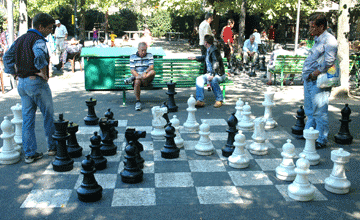 The picturesque road bordering the lake between
Geneva and Montreux is known as La Cote (The Coast). This is where you really start to feel the Swiss obsession with cleanliness, landscaping and flowers. Each and every home or cottage had a fantastic garden
and window boxes full of colorful geraniums and other native flowers, maintaining a continuous stream of color everywhere you look. The picturesque road bordering the lake between
Geneva and Montreux is known as La Cote (The Coast). This is where you really start to feel the Swiss obsession with cleanliness, landscaping and flowers. Each and every home or cottage had a fantastic garden
and window boxes full of colorful geraniums and other native flowers, maintaining a continuous stream of color everywhere you look. Lausanne is the smallest of Switzerland's major cities.
One of its most interesting aspects of Lausanne and the nearby villages of Vevey and Montreux is their literary history. These Swiss locales influenced writers
such as Henry James, Lord Byron and Victor Hugo. In general, Lausanne is considered to be the most open community to art and culture, and that has generated perhaps the largest numbers of scheduled
music festivals, operas and theater productions in the country. It is fitting, then, that the most sophisticated hotel is the Beau-Rivage, one of the "Leading Hotels of the
World." Built in 1861, the grand hotel with five star amenities today is surrounded by 10 acres of picturesque gardens. The hotel has hosted numerous historical international conferences and
negotiations. It is situated in Ouchy, the Olympic Center of Lausanne, and adjacent to the very upscale digs on the shores of Lake Geneva is the interesting Olympic Museum, home of the World Olympics Committee. For
lodging pricing and availability, click here. Read Next Story |
